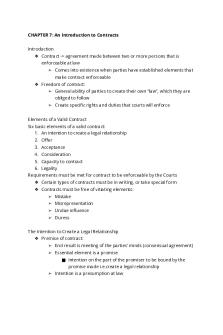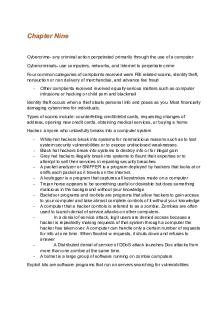Introduction to Contracts and Agreement Notes Chapter 9 PDF

| Title | Introduction to Contracts and Agreement Notes Chapter 9 |
|---|---|
| Course | Legal Environment Of Business |
| Institution | University of Arkansas at Fort Smith |
| Pages | 6 |
| File Size | 66.2 KB |
| File Type | |
| Total Downloads | 107 |
| Total Views | 136 |
Summary
Introduction to Contracts and Agreement Notes for chapter 9...
Description
CHAPTER NINE: Introduction to Contracts and Agreement
INTRODUCTION Contracts are ubiquitous in business relations. A contract is a promise or a set of promises made between parties, the breach of which the law gives a remedy. You need to understand the sources of contract law, how contracts are classified, and the rules that guide the interpretation of contracts. You may assume that it will be easy to tell when someone is making an offer. Given the ambiguity in human behavior though, it is not always so easy. In the real world, a businessperson may have a difficult time distinguishing an offer from a negotiation. This chapter introduces the legal guidelines for determining when an offer has been made and accepted.
LEARNING OBJECTIVES After reading this chapter, you will be able to answer the following questions: , What is a contract? , What are the sources of contract law? , How can contracts be classified? , What are the rules that guide the interpretation of contracts? , What are the elements of a valid offer and valid acceptance? , How may an offer terminate?
SATISFYING THE LEARNING OBJECTIVES
What is a contract? A contract is a set of legally enforceable promises between two or more parties.
A valid contract must have: Agreement (offer and acceptance) Offer – a promise or commitment to do or refrain from doing some specified action in the future Acceptance – voluntary act of the offeree that shows assent or agreement to the terms of an offer. May be express or implied by conduct. It must be unequivocal and communicated to offeror. Consideration Legal object Parties with legal capacity The objective theory of contracts means that the existence and interpretation of a contract is based upon the outward manifestations of intent by the parties. What matters is how the parties represented their intent through actions and words.
What are the sources of contract law? State common law is an important source of contract law. The Uniform Commercial Code (UCC) is an important source of contract law. Article 2 governs contracts for the sale of goods.
How can contracts be classified? Bilateral / unilateral Bilateral – a promise in exchange for a promise. Unilateral – a performance forms the contract, e.g., a reward. Express / implied / quasi Express – all terms are clearly set forth in either written or spoken words. Implied – arises not from words but from the conduct of the parties. Quasi-contracts – implied in law contracts. Prevents one party from getting unjustly enriched at the expense of another. Requires four elements: Plaintiff furnished a service or property Plaintiff expected to be compensated for the service or property
Defendant knew or reasonably should have known that compensation was expected Defendant had a chance to reject the services or property and did not. Valid / voidable / void / unenforceable Valid – contains all the elements of a legal contract. Voidable – an otherwise valid contract that one or both parties has the ability to withdraw from or refrain from enforcing. The party with the option can either ratify/affirm the contract or declare it void. Incapacity allows the party with the deficiency to withdraw from a contract. Also, contracts entered into under duress or undue influence. Void – not a contract at all; neither party can enforce. Fro example, a contract to sell illegal drugs or to perform prostitution where it is against the law. Unenforeceable – a law prohibits a court from enforcing a particular contract. For example, when there is a valid defense to the contract such as the statute of frauds or statute of limitations that you’ll learn about in the next chapters. Executed / executory Executed – terms of the contract have been fully performed. Executory – some terms still need to be performed. For example, a 12 month lease - each month the tenant/lessee has to pay the rent. Formal / informal Formal – some contracts must be created in a specific manner, e.g., letters of credit. Informal – no formalities are required in making them. They can range from simple to complex.
What are the rules that guide the interpretation of contracts? The Uniform Commercial Code governs certain contracts (sale of goods, negotiable instruments, leases, etc.). When there is no guiding statutory scheme, rules are determined by courts. The plain meaning rule says that when a writing appears to be unambiguous, its meaning must be determined from the four corners of the instrument. Words are given their ordinary, common meaning unless the parties clearly intended something else. Certain interpretations are standard. For example, if preprinted and handwritten words both appear on the document, handwritten words prevail.
Court will look at past performance, if any, and industry standards, if applicable. A contract will be interpreted as a whole with individual clauses considered subordinate to general intent. All writings that are part of the same transaction will be interpreted together. Terms subject to separate negotiation will be given greater consideration than boilerplate, standard language. Specific wording is given greater consideration than general wording. The interpretation of a non-drafting party may be given more consideration than that of the author if the language is particularly vague and ambiguous.
What are the elements of a valid offer and valid acceptance? A valid offer requires: Manifestation of the offeror’s intent to be bound Serious objective intention of the offeror; what would a reasonable person think? A statement made in jest, anger or undue excitement doesn't qualify. Expressions of opinion don't qualify. A statement of future intent is not an offer. A request to negotiate is not an offer ("Letters of Intent"). Advertisements to sell are not offers but merely invitations to make offers (internet ad for big screen TV's mistakenly listed for $1). Auctions are offers for bids. With reserve, means the owner can withdraw from sale at any time. Without reserve means the good will be sold to the highest bidder. Definite and certain terms Terms must be reasonably certain or definite; can be found in either offer or acceptance. Communication of the offer by the offeror A valid acceptance requires: Manifestation of intent to be bound by the terms of the offer An acceptance is valid when a manifestation of intent to be bound to the terms of the offer is communicated to the offeror by the offeree – a voluntary act of the offeree that shows assent or agreement to the terms of an offer. May be express or implied by conduct. It must be unequivocal and communicated to offeror. Definite and certain terms Communication of the acceptance by the offeree
Generally, acceptance cannot be by anyone other than the offeree. Silence as acceptance – Generally, silence is never treated as acceptance. However, if past practice or receipt of goods and services where rejection was required but not made, silence can be treated as acceptance. In bilateral contract , communication of acceptance is necessary. In unilateral contract , performance constitutes acceptance. Acceptance is timely if made before offer is terminated.
How does an offer terminate? Ways an offer can be terminated: Revocation by the offeror – unless expressly irrevocable, offer can be revoked at any time prior to acceptance. Revocation can be express or through an act inconsistent with the offer. E.g., you offer to sell your bike but before anyone accepts, you take it to the dump and throw it away. Generally, a revocation is effective upon receipt by the offeree. Rejection by the offeree – once rejection has occurred, any attempt at acceptance will be deemed a new offer. Counteroffer by the offeree – under common law, an acceptance had to exactly mirror the offer. In most cases today, provided that any deviations between the offer and acceptance are minor in nature, a contract is formed and can be enforced. For example, you offer to sell a used bathtub to a neighbor for $10 provided he comes and picks it up in his truck. Instead, he shows up on foot with a skateboard and gives you the $10. The deviation in the form of transportation would likely be considered minor by the courts and the contract enforced. By operation of law Death or incapacity of the offeror – applies unless the offer is irrevocable, with the offer then passing to the offeror’s heirs or assigns. Otherwise, an offer does not pass. Destruction of the subject matter – it must happen before acceptance. For example, I offer to sell you my immaculately restored 1969 Ford Mustang. Before you accept the offer, the car catches fire and is a total loss. Subsequent illegality of the subject matter – must occur before acceptance. For example, Company A (a gun manufacturer) offers to sell Company B (a sporting goods retailer) a shipment of semi-automatic handguns. Before Company B can accept the offer, the legislature passes a law that bans the sale of semi-automatic weapons.
Lapse of time – time starts to run when it is received by the offeree. For example, I will sell you my gold necklace for $20, but I have to have an answer in the next three hours. Failure of other conditions stated in the offer
LET’S DIG DEEPER
The “mailbox rule” In today’s technology age, the mailbox rule may have lost some of its relevance, but the concept remains: If an offeree accepts an offer, the acceptance is valid and the contract is formed when the offeree places the acceptance in the mailbox. However, a revocation of the offer by the offeror is not effective until it is received by the offeree. So, if the acceptance and revocation “cross in the mail”, the acceptance comes first and there is a valid contract. Today, we can apply the mailbox rule to facsimile transmissions and e-mails....
Similar Free PDFs

Introduction to Tally.ERP 9
- 38 Pages

Unit 9 - Introduction to Psychology
- 21 Pages

Introduction to Cybercrime Notes
- 12 Pages
Popular Institutions
- Tinajero National High School - Annex
- Politeknik Caltex Riau
- Yokohama City University
- SGT University
- University of Al-Qadisiyah
- Divine Word College of Vigan
- Techniek College Rotterdam
- Universidade de Santiago
- Universiti Teknologi MARA Cawangan Johor Kampus Pasir Gudang
- Poltekkes Kemenkes Yogyakarta
- Baguio City National High School
- Colegio san marcos
- preparatoria uno
- Centro de Bachillerato Tecnológico Industrial y de Servicios No. 107
- Dalian Maritime University
- Quang Trung Secondary School
- Colegio Tecnológico en Informática
- Corporación Regional de Educación Superior
- Grupo CEDVA
- Dar Al Uloom University
- Centro de Estudios Preuniversitarios de la Universidad Nacional de Ingeniería
- 上智大学
- Aakash International School, Nuna Majara
- San Felipe Neri Catholic School
- Kang Chiao International School - New Taipei City
- Misamis Occidental National High School
- Institución Educativa Escuela Normal Juan Ladrilleros
- Kolehiyo ng Pantukan
- Batanes State College
- Instituto Continental
- Sekolah Menengah Kejuruan Kesehatan Kaltara (Tarakan)
- Colegio de La Inmaculada Concepcion - Cebu












